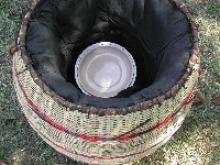Labour-saving technologies and practices: fuel efficient stoves
The following contains explanations about wood burning fuel-efficient stoves and of insulated baskets/boxes. Firstly, the details of the features of wood-burning fuel-efficient stoves are given. These include their high combustion efficiency, reduction in wood consumption, the good transference of the heat from the fire to the pot, minimal smoke emission, ergonomics and structural stability. The materials these stoves require are also given as well as the features of the insulated baskets/boxes. Finally, the advantages and disadvantages are highlighted.
Description
Open fires (usually based on three stones) used in the kitchen require a lot of wood. Indoor pollution from smoke contributes to health problems, such as cardiovascular and respiratory diseases, cancers and eye diseases. There are also risks of burns from unstable cooking pots.
1. Features of wood-burning fuel-efficient stoves
1.1 High combustion efficiency
The higher the combustion efficiency the greater the amount of heat produced and the less smoke produced from the same amount of wood. By controlling the type of fuel used, burn intensity, air and flame mix it is possible to achieve efficiencies of over 90 percent.
1.2 Reduction in wood consumption
Efficient stoves use 40 to 60 percent less wood. Two pot stoves reduce the cooking time and fuel consumption compared to single pot stoves.
1.3 Good transference of the heat from the fire to the pot
Improved by insulating the heat from the outside of the stove, shortening the fire flow path, and reducing the distance between the flame and pot.
1.4 Minimal smoke emission
High combustion efficiency and drawing the smoke through a chimney and venting it to the outside of the home or away from the operator may achieve an almost 100 percent reduction in emissions. The opening to the chimney needs to be designed to draw the smoke up it but at the same time to constrict the flow so that too much heat is not lost up the chimney.
1.5 Ergonomics and structural stability
Stove layout must be user-friendly and enable pots to be moved around. The stoves must be stable as well as the pots when they are on the stove to prevent them from tipping over and causing burns.
1.6 Materials
Stoves are made from a wide range of materials including pottery-lined mud, metal or ceramic-lined metal.
2. Features of insulated basket/box
After the initial cooking of food by traditional methods, food is transferred to an insulated basket or box and cooking is completed using the retained heat. Insulation materials include old clothing materials, newspapers or hay. When cooking in the insulated basket/ box, food has to be cooked thoroughly before being placed in the basket/box.
3. Advantages
- Labour-saving: by making more efficient use of firewood, less time is spent collecting firewood.
- Livelihood resilience strengthening: improvements in health and safety in the home; less firewood collection reduces the rate of deforestation and environmental degradation. More time availability and better health safety enable to create new opportunities and use energy and time in other activities.
- Livelihood diversification: the local manufacture of fuel-efficient stoves for sale is an income-generating opportunity.
- Equipment: low cost and possible to make locally (especially insulated basket/box).
- Skills: minor training required in the safe use of the stoves.
- Cost and risk: equipment is relatively low cost.
- Infrastructure requirements: local manufacture of stoves.
4. Disadvantages
- Cost: although the cost is low it is more expensive than an open fire.
- Skills: incorrect use can damage the stoves (for example, if the water is used to put out the fire, the clay liner cracks). Training is required in safe cooking practices with an insulated basket/box.
- Attitude: changes in traditional beliefs and attitudes may be required, particularly regarding the use of chimneys. For example, some like the smell of smoke and believe that it adds to the flavour of food. Smoke naturally repels insects, animals and termites. Non-portable stoves restrict cooking to one location.
Figure 1. Fireless cooker

©FAO/TECA
5. Agro-ecological zones
- Tropics, warm; and
- subtropics, warm/mod cool.
6. Related/associated technologies
7. Objectives fulfilled by the project
7.1 Labour-saving technology (LST)
The technology efficiently uses firewood and reduces the time for firewood collection.
7.2 Women-friendly
The technology is easy to use and accessible to all. Requires minor trainer for safe usage.
7.3 Resource use efficiency
The technology can be manufacture locally and is environmentally friendly.
